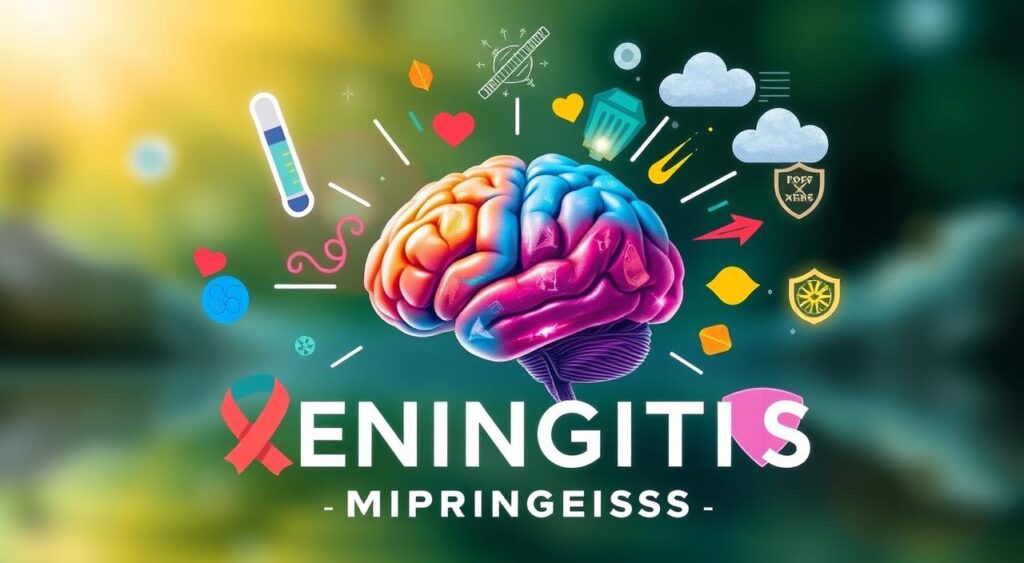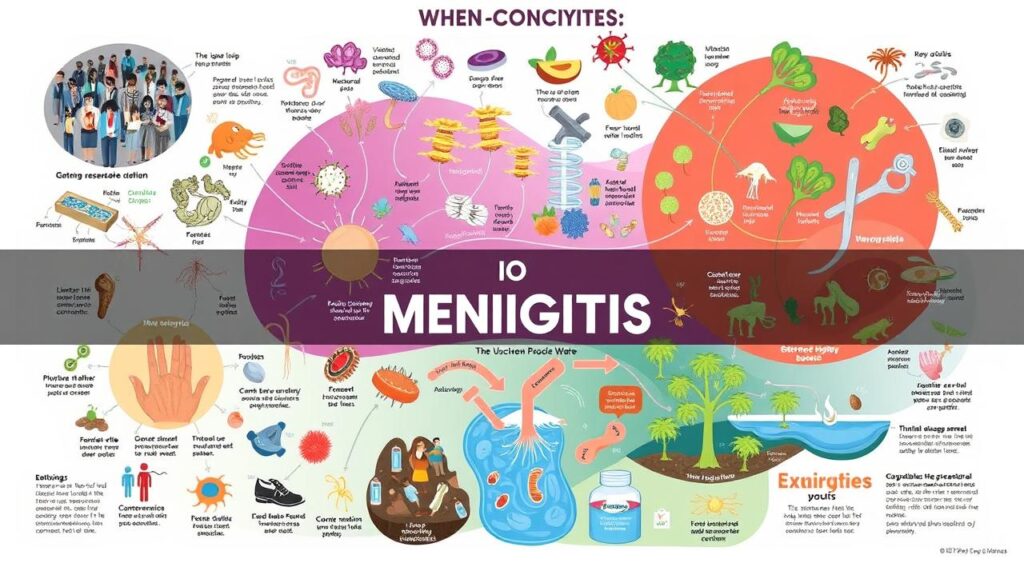Did you know that nearly 1.2 million people get meningitis every year worldwide? This is a scary number that shows how important it is to know about meningitis. Meningitis is when the membranes around the brain and spinal cord get inflamed. It can be deadly if not treated right away.
In this article, we’ll talk about what causes meningitis, its symptoms, and how to prevent it. Knowing about meningitis helps us protect ourselves and our families. It’s key to understanding this condition to act fast and prevent it.

Key Takeaways
- Meningitis affects approximately 1.2 million people per year worldwide.
- Early detection of symptoms of meningitis is crucial for successful treatment.
- There are different causes of meningitis, including bacterial and viral infections.
- Vaccination significantly reduces the risk of contracting certain types of meningitis.
- Adopting healthy practices can minimize the risk of infection.
Understanding Meningitis
Meningitis is a serious condition where the meninges, the membranes around the brain and spinal cord, get inflamed. It’s important to know what causes it, its symptoms, and possible complications. This knowledge helps in understanding the need for meningitis awareness.
The meninges have three layers: the dura mater, arachnoid mater, and pia mater. When these layers get inflamed, it can cause serious health issues. Meningitis can be caused by infections, injuries, or certain medical conditions.
Knowing the symptoms of meningitis is key to getting help early. Symptoms include fever, headache, stiff neck, and light sensitivity. Learning about the different types of meningitis helps in taking preventive steps and knowing when to see a doctor.
Public health officials stress the need for meningitis awareness. They run education programs to spread the word. Their goal is to lower the risk of this serious illness.
| Type of Meningitis | Common Causes | Prevention | Typical Symptoms |
|---|---|---|---|
| Bacterial Meningitis | Infection from bacteria such as Neisseria meningitidis | Vaccination, avoiding close contact | High fever, severe headache, nausea |
| Viral Meningitis | Infection from viruses like enteroviruses | Proper hygiene, handwashing | Mild fever, headache, fatigue |
| Fungal Meningitis | Infection from fungi, typically in immunocompromised individuals | Avoiding exposure to fungal environments | Headache, fever, sensitivity to light |
Types of Meningitis
Meningitis can be classified into several types, each with its own causes and symptoms. Knowing these differences is key for proper diagnosis and treatment. The main types are bacterial meningitis, viral meningitis, and fungal and parasitic meningitis. Each type presents unique challenges.
Bacterial Meningitis
Bacterial meningitis is the most severe form. It’s caused by pathogens like Streptococcus pneumoniae and Neisseria meningitidis. Symptoms appear suddenly and can include:
- High fever
- Severe headache
- Stiff neck
- Confusion or altered mental status
Treatment for bacterial meningitis involves antibiotics and corticosteroids given intravenously. Quick action is crucial to avoid serious complications. Knowing the symptoms is vital.
Viral Meningitis
Viral meningitis is less severe than bacterial meningitis. It’s often caused by enteroviruses. Mumps and herpes viruses can also cause it. Treatment aims to relieve symptoms.
Pain relievers and staying hydrated are important. Most people recover fully from viral meningitis.
Fungal and Parasitic Meningitis
Fungal meningitis is rare and mainly affects those with weakened immune systems. Cryptococcus is the most common fungus involved. Parasitic meningitis, caused by organisms like Naegleria fowleri, is often fatal.
Understanding the causes and symptoms is crucial. These types require specialized medical care.
Meningitis Symptoms to Watch For
It’s vital to know the symptoms of meningitis to get treatment quickly. The early signs can look like other illnesses, so being aware is key. Meningitis shows different symptoms, some more serious than others.
Common Symptoms
The common signs of meningitis start quickly. They might include:
- Fever
- Headache
- Nausea and vomiting
- Sensitivity to light
- Altered mental status
In babies, look out for:
- Irritability
- Poor feeding
- Unusual crying
Spotting these early signs is key to getting medical help fast.
Severe Symptoms That Require Immediate Attention
Some symptoms of meningitis need urgent care. These include:
- Seizures
- Significant decrease in consciousness
- Rapid decline in clinical status
A rash that doesn’t fade under pressure could mean bacterial meningitis. Knowing these serious signs is crucial. It can mean the difference between life and death.
Causes of Meningitis
Meningitis can be caused by different pathogens. The main causes are bacterial, viral, and fungal. Each has its own way of spreading and characteristics. Knowing these helps prevent meningitis.
Bacterial causes are the most serious. They include Neisseria meningitidis and Streptococcus pneumoniae. These bacteria spread in crowded places. This is why outbreaks happen in college dorms, military barracks, and daycare centers.
Viral causes come from enteroviruses, common in warmer months. These viruses spread in communities, causing mild to moderate illness. While viral meningitis usually gets better on its own, it can still cause a lot of discomfort.
Fungal causes are rare and affect people with weak immune systems. Fungi like Cryptococcus neoformans can cause meningitis. This usually happens when someone breathes in fungal spores, which then reach the brain.

Knowing the causes of meningitis is key to preventing it. By understanding the different pathogens, we can educate and protect people. This helps lower the risk of this serious illness.
| Type of Meningitis | Common Pathogens | Transmission Methods | At-Risk Populations |
|---|---|---|---|
| Bacterial Meningitis | Neisseria meningitidis, Streptococcus pneumoniae | Direct contact, respiratory droplets | Individuals in crowded settings |
| Viral Meningitis | Enteroviruses, Herpes Simplex Virus | Close contact, respiratory secretions | General population, especially children |
| Fungal Meningitis | Cryptococcus neoformans | Inhalation of fungal spores | Immunocompromised individuals |
Risk Factors Associated with Meningitis
Knowing the meningitis risk factors helps us find who’s most at risk. It also helps us make better prevention plans. Age and health conditions are key in figuring out who might get meningitis.
Age and Meningitis
Some groups, like babies, young kids, and teens, are more likely to get meningitis. Babies are especially at risk from bacterial meningitis. Young kids, especially those starting school, face a higher risk of viral meningitis.
Being aware of these age groups helps us act fast to protect them.
Medical Conditions That Increase Risk
People with weakened immune systems are more likely to get meningitis. Conditions like diabetes or other health problems can also raise the risk. If someone has had a head injury, they might be even more at risk.
It’s important to watch for changes in health and know about these conditions. This helps keep those at risk safe and healthy.
How Meningitis Spreads
Meningitis spreads mainly through respiratory droplets when someone coughs or sneezes. It’s important to know how contagious meningitis is. This is especially true in places where people are close together, like in communal living or at crowded events.
Direct contact with someone who has meningitis can also spread the disease. This includes kissing or sharing things like utensils and drinks. The germs can stay on surfaces for a bit, making it easier to get infected.
It’s crucial to take preventive steps, especially in places where the risk is higher. People should be mindful of their surroundings and take precautions. This includes:
- Regular handwashing with soap and water
- Avoiding close contact with sick individuals
- Staying up-to-date with vaccinations
- Using disposable tissues when sneezing or coughing
Understanding how meningitis spreads helps protect ourselves and our loved ones. Knowing how it spreads empowers us to take steps to prevent infections.
| Method of Transmission | Description |
|---|---|
| Respiratory Droplets | Coughing or sneezing by an infected person |
| Direct Contact | Kissing or touching infected areas |
| Shared Items | Using items like utensils or drinks with an infected person |
| Surface Contact | Touched surfaces that harbor the bacteria or viruses |
Diagnosis of Meningitis
Diagnosing meningitis requires several important steps. A lumbar puncture, or spinal tap, is often used. It takes cerebrospinal fluid for analysis. This fluid is checked for pathogens to identify the meningitis type.
Other tests include blood tests and imaging studies. These help give a full picture of the patient’s health.
Tests Used to Diagnose Meningitis
Several tests help diagnose meningitis accurately:
- Lumbar puncture: Essential for analyzing cerebrospinal fluid.
- Blood tests: Help identify infections and inflammatory markers.
- Imaging studies: CT or MRI scans can reveal swelling or inflammation.
- Clinical evaluations: Involves assessing symptoms and medical history.
When to Seek Medical Attention
Seek medical help for meningitis if you have emergency symptoms. These include:
- Severe headache or neck stiffness.
- Confusion or changes in mental status.
- Rash or skin changes.
- Vomiting or sensitivity to light.
If you’ve been near someone with meningitis, get tested too. Even if you feel fine. Quick action can prevent serious problems.
Treatment Options for Meningitis
Treatment for meningitis depends on the type of infection. Quick action is key for managing the condition. Bacterial meningitis needs antibiotics fast, while viral meningitis focuses on support.
Antibiotic Treatment for Bacterial Meningitis
Bacterial meningitis is an emergency that often requires hospital care. Antibiotics are given through an IV right away to prevent serious problems. Sometimes, corticosteroids are added to reduce swelling.
Supportive Care for Viral Meningitis
Viral meningitis treatment is different. It focuses on managing symptoms and caring for the patient at home. Drinking plenty of water, taking pain relievers, and resting are important. Regular check-ups help ensure a full recovery.
| Type of Meningitis | Treatment Approach | Key Components |
|---|---|---|
| Bacterial Meningitis | Intravenous antibiotics | Corticosteroids for inflammation, hospitalization |
| Viral Meningitis | Supportive care | Hydration, pain relief, rest, follow-up care |
Prevention Tips for Meningitis
Preventing meningitis is key for public health. Focus on vaccinations and healthy habits to lower risks. Knowing about vaccines and hygiene helps protect everyone.
Vaccination Recommendations
Vaccines are crucial in preventing meningitis. The main vaccines are:
- Meningococcal vaccine
- Pneumococcal vaccine
- Haemophilus influenzae type b (Hib) vaccine
It’s important to get vaccinated, especially for those at high risk like college students and military recruits. Regular vaccinations help lower meningitis cases.
Healthy Practices to Avoid Infection
Good hygiene is key in preventing meningitis. Healthy habits include:
- Wash hands often with soap and water.
- Avoid close contact with sick people.
- Don’t share personal items like utensils or drinks.
- Practice good respiratory hygiene, like covering your mouth when coughing.
Teaching communities about these practices helps prevent meningitis. Awareness and action make our environments healthier.
| Vaccine | Recommended Age | High-Risk Groups |
|---|---|---|
| Meningococcal | 11-12 years, booster at 16 | College students, military recruits |
| Pneumococcal | 2 months, 4 months, 6 months, and 12-15 months | Older adults, immune-compromised individuals |
| Hib | 2 months, 4 months, 6 months, and 12-15 months | Children under 5 years |
Living with Meningitis: Next Steps
Adjusting to life after meningitis takes careful monitoring and ongoing support. People might face symptoms of chronic meningitis or lasting effects like headaches or changes in thinking. It’s key to spot these symptoms early to manage them well.
Support services for meningitis are vital for recovery. They include rehabilitation and counseling, helping people deal with the condition’s challenges. Joining support groups and talking to health experts can offer emotional and practical help.

Understanding your health is crucial during recovery. Patients should work with their doctors to make care plans. Regular check-ups help track progress and tackle new health issues.
| Support Services | Description | Benefits |
|---|---|---|
| Rehabilitation Programs | Therapeutic activities aimed at restoring physical and cognitive function | Improved ability to perform daily tasks and regain independence |
| Counseling Services | Professional emotional support for coping with illness | Enhanced emotional wellbeing and stress management |
| Support Groups | Peer-driven forums for sharing experiences and advice | Sense of community and understanding |
Living with meningitis can bring unexpected challenges. Using available resources leads to better outcomes and a better life. By focusing on health and getting the right support, people can manage meningitis’s long-term effects.
Meningitis Awareness and Education
Boosting meningitis awareness is key to fighting the disease. Knowing how to spot meningitis early can save lives. Communities gain a lot from materials that explain the risks and signs of meningitis.
Importance of Public Awareness
Public health efforts to raise meningitis awareness are vital. They help people and families know the signs and what to do if there’s an outbreak. Health groups are focusing on teaching how to recognize meningitis to prevent and treat it.
Resources for Further Learning
There are many resources for learning more about meningitis. The CDC and WHO offer detailed educational materials. Local health departments also connect people with meningitis support groups, providing knowledge and support.
Conclusion
Meningitis is a serious condition that can harm health. It’s important to know about it and how to prevent it. This article has covered everything from types and symptoms to prevention strategies.
Knowing the signs of meningitis and when to get help is crucial. It can save lives. It’s also key to understand the causes and treatments.
Education and awareness are vital in fighting meningitis. By staying informed, we can help protect our health and the health of others. It’s important for communities to work together to share knowledge and lower risks.
Combating meningitis needs everyone’s help. By learning about it, we can make a big difference in public health. Together, we can keep meningitis from harming future generations.
FAQ
Q: What is meningitis?
A: Meningitis is when the protective membranes around the brain and spinal cord get inflamed. This can happen due to bacteria, viruses, or fungi. Knowing the symptoms is key to getting help early.
Q: What are the common symptoms of meningitis?
A: Symptoms include fever, severe headache, and nausea. You might also feel sick to your stomach, be sensitive to light, or act differently. Babies might get upset easily, not want to eat, or cry in a strange way.
Q: How is bacterial meningitis different from viral meningitis?
A: Bacterial meningitis is more serious and can be life-threatening if not treated. It needs antibiotics. Viral meningitis is usually milder and might get better on its own. It’s all about managing symptoms and staying hydrated.
Q: What are the main causes of meningitis?
A: Meningitis can come from different sources like bacteria, viruses, fungi, and sometimes parasites. Knowing this helps in preventing it.
Q: What should I do if I suspect meningitis?
A: If someone has severe symptoms like seizures, acts very differently, or has a rash that doesn’t go away, get help right away. Quick action is crucial for treatment.
Q: How does meningitis spread?
A: It spreads through droplets in the air, touching someone who’s sick, or sharing things. Being in crowded places can increase the risk. It’s important to know how to prevent it.
Q: Are there vaccines available for meningitis prevention?
A: Yes, there are vaccines like meningococcal, pneumococcal, and Hib. They help prevent bacterial meningitis. They’re especially important for people at high risk.
Q: What are the long-term effects of meningitis?
A: Some people might have ongoing issues like headaches or changes in thinking. It’s vital to keep an eye on your health and get help if needed.
Q: Where can I find more information about meningitis?
A: You can find lots of information on meningitis at places like the Centers for Disease Control and Prevention (CDC) and the World Health Organization (WHO). They offer educational materials, support, and the latest updates.
